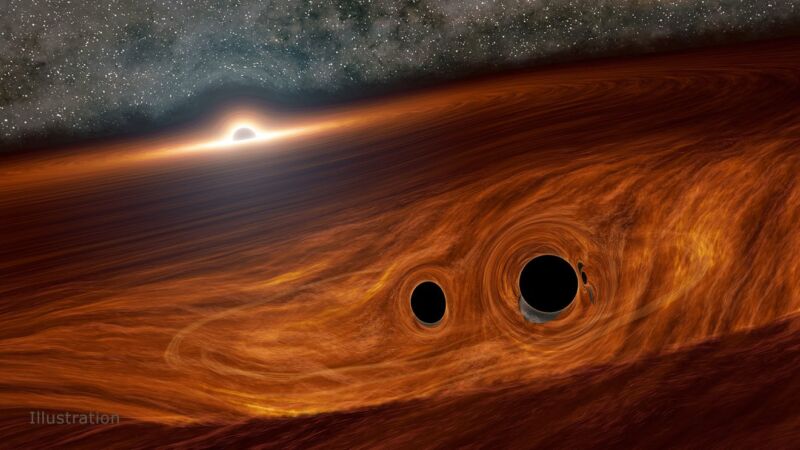As we carefully map the stars of our Milky Way, we're able to identify features that tell us of its history. These include local details, such as the stars that have passed through an area from which something would be able to detect Earth. And it includes far larger structures, like the trails of stars left behind by smaller galaxies that have merged with our own.
But one feature we've discovered has been a bit confusing: trails of stars that are too small and thin to have come from a galaxy collision. There are dozens of them that we've not identified a source for. Their size suggests they came from a globular cluster, but there's no obvious mechanism for these clusters to eject stars at a rate sufficient to generate this sort of stream.
Now, a team of researchers has suggested a not-so-obvious mechanism: Over time, clusters may become dominated by black holes that eject all the stars.
Unclustering
Globular clusters are dense groups of stars that orbit the Milky Way together. They're held in association by their mutual gravity. Complex interactions will inevitably eject some of the stars, but not at an appreciable rate, which makes the clusters extremely long-lived.
The researchers started their work, however, by looking at an unusual globular cluster called Palomar 5. It has both extended tails of lost stars, and its total mass is relatively small, making it diffuse compared to other clusters we've studied. The lower density makes it easier for Palomar 5 to lose stars, but it could also have been caused by past star loss, creating a bit of a chicken-and-egg problem. So, the researchers decided to model globular cluster evolution and try to find a model that could produce something that looks like Palomar 5.
The researchers created a model that takes a cluster of stars and models their gravitational interactions with each other and the Milky Way as they orbit the galactic center. Thanks to some help from a cluster of GPUs and the right software, they were able to run these simulations for billions of years. By changing the parameters, they could find which factors were associated with clusters that ended up looking like Palomar 5.
The secret ingredient turned out to be black holes. When black holes stayed in the cluster following their formation—meaning the supernova didn't impart enough motion to send them flying off elsewhere in the galaxy—they gradually ejected nearly 90 percent of the cluster's mass. This drops the density of the cluster nearly three orders of magnitude, in part by star ejections and in part by the black holes driving off gas and other material by heating it.
In the model that best fit Palomar 5, the cluster was left with nearly a quarter of its content being black holes, with 124 of them in total. These black holes were also substantially more massive than they would have been at formation (average mass being about 17 times that of the Sun), suggesting they had fed extensively or undergone mergers.
The future is black
The researchers also looked at model runs that didn't produce a cluster that looked like Palomar 5 to understand how black holes could influence globular cluster evolution. The key factor that determines whether a cluster has a black-hole-rich future is its initial density. If the star cluster is dense enough, the gravitational interactions tend to eject black holes before they can take over.
If a cluster is going along this path, then it will eject over half its stars over a three billion year period, and this is a sufficient rate to create the trails of stars that started this investigation.
In lower density clusters, the black holes end up near the center, and stars get ejected instead. The researchers say that, under some conditions, a cluster can evolve to the point where it's essentially 100 percent black hole, with almost all the stars ejected.
The big weakness of the model is that it doesn't include interactions among the stars, black holes, and the gas found in the cluster. The last of these factors, the gas, can mediate friction that can slow bodies and prevent their ejection, but it was left out of the model.
On the plus side, this can be checked against reality. The fact that tails are mostly produced during the end stage of some clusters suggests that only a fraction of the globular clusters in the Milky Way should have them—roughly four. And tracking the motion of stars within a cluster should be able to detect the gravitational influence of black holes, allowing us to get an estimate of their numbers. So, it's possible that this idea will be tested before we have sufficiently powerful GPUs to run similar simulations that include gas.
Nature Astronomy, 2021. DOI: 10.1038/s41550-021-01392-2 (About DOIs).



3175x175(CURRENT).thumb.jpg.b05acc060982b36f5891ba728e6d953c.jpg)

Recommended Comments
There are no comments to display.
Join the conversation
You can post now and register later. If you have an account, sign in now to post with your account.
Note: Your post will require moderator approval before it will be visible.